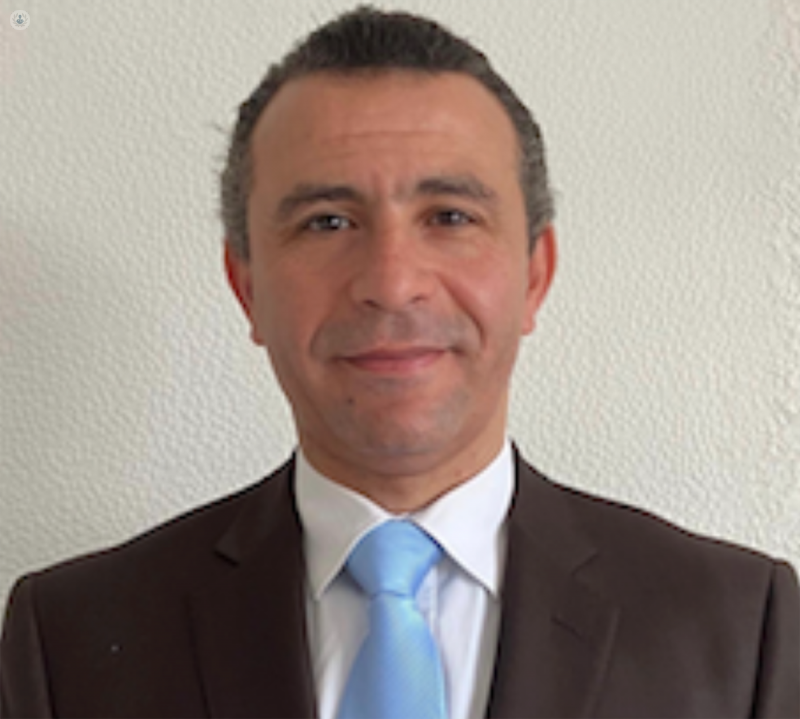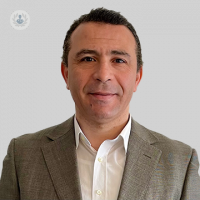Carotid endarterectomy: preventing another stroke
Written by:The carotid artery is an artery that comes from the aorta in the chest and supplies the face and the brain with oxygenated blood. There is one carotid artery in each side of the neck and each divide at the middle of the neck into external and internal carotid arteries to supply blood to the face (external) and the brain (internal) of the corresponding side. If one of the internal carotid arteries becomes narrowed, it can lead to a stroke and a carotid endarterectomy may be needed to prevent another one happening.
We spoke to Mr Mohamed Abdelhamid, a top consultant vascular and endovascular surgeon, to find out what causes carotid artery disease, how patients are treated and what the recovery is like following a carotid endarterectomy procedure.

What is carotid artery disease?
Carotid artery diseases include narrowing (stenosis) or swelling (aneurysm) of the carotid artery. Narrowing of the carotid arteries usually happens when fatty deposits and blood cells (plaque) clog up the inside of the artery. If the plaque breaks off, this can send small clots or debris to the brain and blocks the small arteries in the brain causing damage.
If the damage is minimal and you recover quickly, then it is called a mini-stroke, or transient ischaemic attack (TIA). If the damage is large or affects the function of the brain tissue, then it is known as a stroke. The recovery after a stroke depends on many factors including the size of the stroke, the centres affected by the stroke and in some cases, whether the clot has been diluted and sucked off by a procedure called suction thrombectomy.
What are the main symptoms?
Narrowing of the carotid arteries is usually without symptoms. If left untreated, it can cause the plaque to break off, leading to a stroke or mini-stroke; some of these can be fatal.
Before causing a stroke, patients with carotid artery disease should be taking medications to thin the blood (antiplatelets) and cholesterol-lowering medication (statins) to lower the risk of developing a stroke. If you developed a stroke secondary to carotid artery disease, this could be treated with an operation to prevent having another stroke.
Is surgery the only treatment option?
There are three ways to treat patients following a stroke or mini-stroke due to carotid artery disease:
- Carotid endarterectomy — this is an open surgery and the gold standard procedure. It is preferable to be done within the first two weeks after the stroke for maximum benefits.
- Stent insertion — a doctor may decide to place a stent across the narrowed carotid artery. This is an evolving treatment and isn’t as commonly practiced as open surgery. It also carries a higher risk of causing a stroke during the procedure. There are specific cases that require a stent and not open surgery. Examples of this include previous neck surgery, previous radiation to the neck and long disease of the internal carotid artery.
- Conservative treatment — by following what is called best medical therapy (BMT), you should be taking blood thinners and anti-cholesterol tablets in addition to controlling any risk factors (stopping smoking, controlling blood pressure, etc.). This is typically followed up with surgery or a stent insertion; however, some patients might only require Best Medical Therapy without any intervention.
How is carotid endarterectomy performed?
Carotid endarterectomy is an open surgical procedure that aims to clear the plaque inside the carotid artery to reduce the risk of developing another stroke. It can be done under general or local anaesthesia.
The surgery requires a cut in the side of the neck and exposure of the common, external and internal carotid arteries. After securing and clamping the arteries, a cut is made in the artery to remove the plaque. We use a plastic tube called a shunt to maintain the blood flow to that side of the brain during the procedure. Some patients do not need the use of the shunt due to good compensation of blood flow from the artery of the other side. After clearing the artery from the debris and clots, we usually close the artery with a patch to keep it wide and open. This reduces the risk of the artery narrowing again. The operation takes about two hours and after you will go to the high dependency unit for monitoring.
Does the procedure carry risks?
Like any surgery, there are some risks involved with the operation; some specific to the operation and others to the anaesthesia. The main risks involved include developing a stroke during the operation or in the first few days after the procedure. This risk is in the range of 1-2% of cases.
Other risks include bleeding, collection of blood under the wound, bruising, hoarseness of voice, numbness of the skin of the cheek, heaviness of the tongue, wound infection, chest infection, heart attack and deep vein thrombosis. There is a rare risk of patch infection that may need further surgery to remove the infected material.
The short-term aftercare
You would normally stay in the hospital for 24-48 hours after the procedure before going home. The full recovery usually takes 1-2 weeks and in the majority of cases, no stitches need to be removed. If stitches do need to be removed, this should be done on the fifth day after the operation. There are some important steps that you need to take during your recovery:
- The wound needs to stay dry and clean for 5 days
- You should not be getting water on the wound for 5 days after the operation
- Antibiotics aren’t normally required; however, if there is a suspicion that wound infection is present, you should take the antibiotics which are typically given by your GP or the hospital doctors
- Painkillers can be taken if there is pain around the wound in the neck
- Strenuous exercise should be avoided after carotid endarterectomy for 4-6 weeks
- Flying is usually delayed for 2-4 weeks after the operation
The long-term aftercare
You should be able to re-start all the regular medications after the procedure. You will be on best medical therapy for life. Smoking should stop and the risk factors should be controlled. Following the operation, you do not need long term follow-up or surveillance. You will, however, need to be seen in the outpatient clinic 6 weeks after the operation, unless there is a reason to be seen earlier e.g. pain, redness of the wound or weakness on the opposite side of the body.
Mr Mohamed Abdelhamid is a leading consultant vascular and endovascular surgeon based at several highly regarded London clinics. To make an appointment with him, visit his Top Doctors profile and check his availability.


